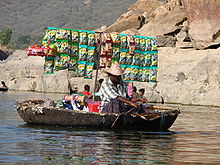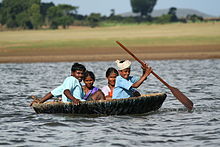- Indian coracles
-
Indian coracles(Tamil:பரிசல்) are commonly found on the rivers Kaveri and Tungabhadra in Southern India.[1] Coracles are primitive, light, bowl-shaped boats with a frame of woven grasses, reeds, or saplings covered with hides.[2] Indian coracles are considered to have been in existence since prehistoric times,[2] and are a major tourist attraction at the Hogenakkal falls on the Kaveri river.[3] Although these boats were originally designed for general transport, they have recently been used mostly for giving tourists rides.[4]
Contents
Types
The coracles found in the Hogenakkal are of two types, which differ mainly in size. The smaller ones are about 6.2 feet (1.9 metres) in diameter, and are used primarily for fishing. The larger ones, which measure up to 8.4 feet (2.6 metres) in diameter, are used for tourists.[5]
Design
Indian coracles are either saucer or bowl shaped and circular, with the greatest diameter across the mouth. The circular coracles in Iraq are very similar, but they have convexly curved sides, and thus the mouth is not the widest part.[1] Indian coracles are on average about 7.3 feet (2.24 metres) in diameter,[5] but can still hold eight people at a time.[3] Other kinds of coracles usually can only hold one person.[6] Indian coracles, and coracles in general, are made of bamboo and take about a day to build, given all the necessary materials.[5] The bottoms of the boats are covered in hides, or sometimes with sheets of plastic, in order to make them waterproof.[7] In modern times, a sheet of LDPE plastic is often embedded between two layers of bamboo. Sometimes the bottom of the craft is tarred to make it waterproof. Coracles are steered and propelled using a single paddle, making them unique.[5]
Construction
The boats are made primarily from bamboo. The first step in construction is a basic framework woven from bamboo sticks. Then the bottom is further reinforced with the addition of more bamboo sticks, making the boat's base sturdy. Once the bottom is structurally sound, the lowest points of the sides are defined by a circumferential band of three flat strips of bamboo woven into the existing lattice. The sides of the boat are then made with 20 to 30 adjacent strips of bamboo. Finally this framework is again strengthened by lightweight bamboo, making sure that the sides are not heavier than the base.[5]
The boats had earlier been waterproofed by using hides of animals, but these days plastic sheets are used for this purpose as they are cheaper as well as easily available.[5] The waterproofing is further enhanced by a layer of tar,[5] a feature which is common in most contemporary coracles.[6][8]
Local names
See also
- Fishing coracles
References
- ^ a b Coracles of South India
- ^ a b Encyclopædia Britannica - Coracle
- ^ a b The Hindu - Row, row, row your boat
- ^ Hogenakkal on TBeez.com
- ^ a b c d e f g h i Boats of South Asia- by Sean McGrail el al.,
- ^ a b The Coracle - a one person boat with an ancient lineage.
- ^ Hide boats at Hogenakal on the river Kaveri, Tamil Nadu- by C Palmer et al.
- ^ How to make a coracle?
- ^ Hogenakkal falls
Categories:- Boat types
Wikimedia Foundation. 2010.



